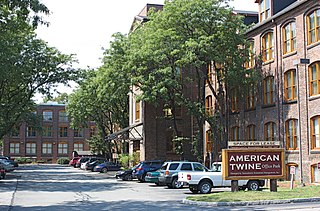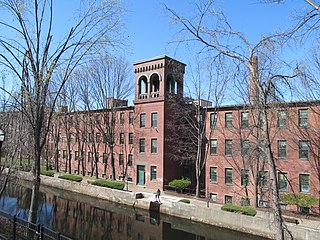
The Russell Company Upper Mill is an historic structure in Middletown, Connecticut, at the junction of Russell Street and East Main Street in South Farms, at the end of East Main Street's commercial and industrial development areas. Built in 1836, it is listed on the National Register of Historic Places. There is a small pond to the south. Small businesses border the street to the north, followed by the buildings of Russell Manufacturing Company, the area's most dominant feature. Russell Street crosses Sumner Brook nearby and ascends to a large residential district to the west. The mill is currently a condo-apartment complex.

Two 19th century factory buildings are sited on a bank beside Starr Mill pond on Beverly Heights just off Middlefield Street. Each building is 3½ stories tall, and overlooks a picturesque pond and woods to the west; a parking lot packed with trucks and industrial equipment on the south; and nineteenth century housing on Beverly Heights to the north.

The Estey Organ Company was an organ manufacturer based in Brattleboro, Vermont, founded in 1852 by Jacob Estey. At its peak, the company was one of the world's largest organ manufacturers, employed about 700 people, and sold its high-quality items as far away as Africa, Great Britain, Australia, and New Zealand. Estey built around 500,000 to 520,000 pump organs between 1846 and 1955. Estey also produced pianos, made at the Estey Piano Company Factory in New York City.

The Beaman and Smith Company Mill is an historic factory complex at 20 Gordon Avenue in Providence, Rhode Island. It consists of two masonry buildings at the junction of Gordon and Saratoga Streets in south Providence. The older of the two buildings is a one-to-two story brick structure, built in 1898 by the Berlin Iron Bridge Company. It has a steel frame, and is about 250 feet (76 m) long. The second building is an early example of concrete slab construction, built in 1917. It was designed by local industrial architecture firm, Jenks & Ballou. It is four stories in height, and is attached to the older building's south face. It originally had a brick surface, but much of this was stuccoed. The brick building presents four bays to Gordon Street, while the concrete one has two. The complex exemplifies two notable early modern construction methods, and is a symbol of the industrial development of south Providence in the late 19th century. Beaman and Smith was a manufacturer of precision machine tools; they went out of business in 1926. The complex was occupied for many years by the James Hill Manufacturing Company, who produced metal containers.

The Providence Jewelry Manufacturing Historic District is a predominantly industrial historic district in Providence, Rhode Island. It covers a roughly 19-acre (7.7 ha) area in the city's Jewelry District, just south of Downtown Providence. While the area began as a residential neighborhood, it emerged in the late 19th and early 20th centuries as a center of Providence's jewelry manufacturing businesses. The oldest industrial building in the district is the 1848 Elm Street Machine Shop, a 2+1⁄2-story stone structure that now houses offices of Brown University.

The American Net and Twine Company Factory is a historic factory at 155 2nd Street in Cambridge, Massachusetts. It was built in 1875 by the nation's first manufacturer of cotton fishing nets. It now houses corporate office space. It was listed on the National Register of Historic Places in 1982.

The Blake and Knowles Steam Pump Company National Register District encompasses the historical industrial complex of the Blake and Knowles Steam Pump Company and its successor, the Worthington Pump and Machinery Corporation in East Cambridge, Massachusetts. It is located in a one-block area surrounded by Third, Rogers, Binney, and Fifth Streets. The property was developed by the Blake and Knowles Steam Pump Company, one of the nation's leading manufacturer of industrial pumps from the late 19th century into the mid-20th century. The district was listed on the National Register of Historic Places in 1997.

This is a list of the National Register of Historic Places listings in Detroit, Michigan.

Ames Manufacturing Company was a manufacturer of swords, tools, and cutlery in Chicopee, Massachusetts, as well as an iron and bronze foundry. They were a significant provider of side arms, swords, light artillery, and heavy ordnance for the Union in the American Civil War. They also cast several bronze statues, which can be found throughout New England.

The Baystate Corset Block is a historic commercial block at 395–405 Dwight St. and 99 Taylor Street in Springfield, Massachusetts, United States. Built in 1874 and twice enlarged, it was from 1888 to 1920 home of the Baystate Corset Company, one of the nation's largest manufacturers of corsets. The building was listed on the National Register of Historic Places in 1983.

Westfield Whip Manufacturing Company is a historic factory at 360 Elm Street in Westfield, Massachusetts. Built about 1887, it is the best preserved of Westfield's extant whip factory buildings. It is also home to the last surviving business of the many whipmakers that once operated in Westfield. The factory was listed on the National Register of Historic Places in 1985, and included in an expansion of the Westfield Center Historic District in 2013.

The Smith Carriage Company District encompasses three buildings on Park Street, Springfield, Massachusetts, between Main and Willow Streets. The buildings, located at 12, 14–38, and 11–31 Park Street, are noted for their historic association with the locally important Smith Carriage Company, a major manufacturer of carriages in the 19th century. The district was added to the National Register of Historic Places in 1983.

The H. M. Van Deusen Whip Company is an historic factory building at 42 Arnold Street in Westfield, Massachusetts, USA. Built in 1917, it is the last purpose-built whip factory to be built in Westfield, which was nationally known as "Whip City". The building, used until 1930 for whip production, was also somewhat retardaire in design, using late 19th-century construction methods. The building was listed on the National Register of Historic Places in 1987.

District B is a historic worker housing district located in Manchester, New Hampshire, United States, near the former Amoskeag Manufacturing Company millyard. It is roughly bounded by Canal, Mechanic, Franklin, and Pleasant Streets, and was added to the National Register of Historic Places on November 12, 1982. It contains 32 contributing properties, including seventeen rowhouse tenement blocks built mainly between 1838 and 1850, in an area of approximately 170 acres (69 ha).

The Strouse, Adler Company Corset Factory is a historic factory complex at 78-84 Olive Street in New Haven, Connecticut. Developed between 1876 and 1923, it was the largest and oldest of the city's several corset manufacturers, and remained in continuous operation for that purpose until 1998. The complex was listed on the National Register of Historic Places in 2002. It has since been converted into residential use.

The Westfield Center Historic District is a historic district encompassing 157 acres (64 ha) of the civic, commercial, and industrial heart of Westfield, Massachusetts. It represents a major expansion of the Westfield Center Commercial Historic District, which included only two blocks of buildings along Elm Street in downtown Westfield. The district includes buildings representing the city's growth in the 19th century as a center of the whip-making industry, and its early years as a center for statewide educational institutions, as well as its growth as a regional center of western Hampden County. The commercial district was added to the National Register of Historic Places in 2008; the expansion and renaming of the district took place in 2013.

The Sanford Whip Company is a historic factory located at 330 Elm Street in Westfield, Massachusetts. Built in 1883, it was owned and operated by one of the whip-making business that led Westfield to become widely known as "Whip City". The building for many years housed a novelty toy manufacturer after the market for whips declined in the early decades of the 20th century. The factory was listed individually on the National Register of Historic Places in 2008, and as part of an expanded Westfield Center Historic District in 2013. It has been converted into affordable housing space.

The Hoyt Shoe Factory is a historic factory complex at 470 Silver Street and 170 Lincoln Street in Manchester, New Hampshire. It consists of two once-identical four-story brick factory buildings which face each other across Silver Street. Built in the 1890s, they housed the city's largest shoe manufacturer, an industry that gained in significance as its textile industry declined. The complex was listed on the National Register of Historic Places in 1985.

The Richmond Underwear Company Building is a historic industrial facility at 65 Millet Road in Richmond, Vermont. Built in 1900, it was the town's first major industrial facility, bringing an economic boom to the town. The factory was used for the manufacture of underwear until 1946, and has seen a variety of industrial and commercial uses since then. It was listed on the National Register of Historic Places in 1992.

The Bigelow-Hartford Carpet Mills were once one of the largest manufacturers of carpeting in the United States. The company's early 20th-century factories, located in Thompsonville, Connecticut, were listed on the National Register of Historic Places in 1983. Used by a succession of carpet makers until the 1960s, the company complex has for the most part been converted to residential use.























